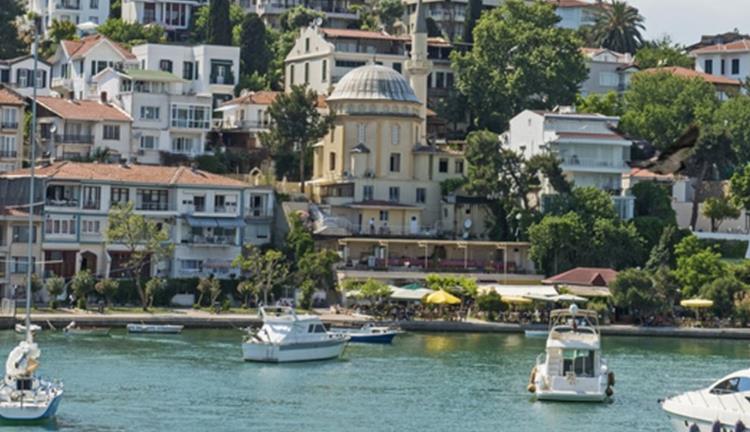6 Unknown Islands of Istanbul and Stories You Never Hear Before

Burgazada
It is said that Burgodada, the third in terms of size of the Istanbul Islands, Metodios, one of the most respected names of the Orthodox church, was captured. Rumour has it that Metodios was taken prisoner in the church of Ayios Ioannis in Burgazada. According to the legend, there is an 11-step dungeon under the church, and it is said that he served as a priest after he was captured. Evliya Çelebi writes that in the 17th century the population of Burgazada consisted of a small number of Jews and Armenians. In his diary for Evliya Çelebi Burgazada "Castle is a small fortress on four corners on the shore of the sea. The island is 10 miles wide and very productive. There are well houses with fresh water up to 300 gardens. People are Greek. There is no account of the vineyards in the mountains. The people are wealthy sailors ". Sait Faik Abasıyanık lived in Burgazada. The only mosque on the island is the Burgazadası Mosque, built-in 1953 to commemorate the conquest of Istanbul. Among the must-see places on the island; Sait Faik Abasıyanık Museum, Hagios Ioannis Prodromos- Aya Yani Church, Bayraktepe- Burgazada Metamorfosis Hristos Monastery- İsa Tepesi, Kalpazankaya.
Yassıada
Yassiada is a very small island. The land where the island meets the sea is flat, and the area is steep. This island is one of the islands used by Byzantium for exile. It was invaded by Russian and Latins. After the conquest of Istanbul, the monastery was abandoned. Sir Henry Bulwer (British Ambassador to Istanbul) acquired the island in 1859. Weird buildings and agriculture were made on the island. The island was later sold to the Egyptian Khedive Ismail Pasha. It was purchased by the Navy in 1947. The real fame of the island was in 1960. The court established here on 27 May 1960 and Prime Minister Adnan Menderes and Hasan Polatkan and Rustu Zorlu, members of the government, were sentenced to death there. The Supreme Court of Justice was established on the island, and government officials and politicians were tried on this island. Afterwards, training activities continued until 1978 by the Naval Command. It was transferred to Istanbul University Faculty of Fisheries between 93-95.
Sedef Island
Sedef Island, which is the smallest island open to settlement among the Princes' Islands, is named as a result of its analogy with mother of pearl. On the other hand, the name Tavşanadası was also used because of the abundance of the rabbit. The most important exile of the island, which was used as a place of exile during the Byzantine period, is Patriarch Ignatios. Ignatios have been subjected to various tortures here for ten years. In 867, the Patriarch was elected again. In 1850, the island was purchased by Damat Ferid Pasha. Pasha grew vegetables on the island and planted olive trees. The island remained neglected with the death of Pasha. During World War I, the trees on the island were cut down. During the occupation of Istanbul, the Yavuz Armored Army was anchored on this island.
Kınalıada
Kınalıada is the smallest of the Princes' Islands. Kınalıada is named after the shrubs that are found on them as red colour. Kınalıada is a rocky island. It is known that stone was brought from this island during the Byzantine period. The fact that water and electricity came to Kınalıada late made it calmer. Electricity came to the island in 1946. He survived thirst in 1981. The old names of the island are Proti and Akoni. It is also the closest island to the city of exile. The most important exile known to this island is that Romans Diogenes was burned and his eyes carved during the period of VII Dukas Mikhail. Attractions on the island include Ayazma Beach, Hristos Hill and Monastery, the Armenian Church of the Holy Krikor Lusarovic.
Büyükada
Büyükada is the largest island of Adalar Municipality, and it's surface area is 5.4 km2. The population of the island is about 3 thousand in the first half of the 19th century. Later, it started with the ferry. In the first quarter of the 20th century, it had a Greek-dominated population. After the Republic and the First World War, the Greek people on the island decreased. By the 1930s, the island's vitality was lost. In the late 1940s, the high bureaucracy became a popular destination for the notables of the state. After a while, it became a place visited by the people of Istanbul on a daily basis. The first building on Büyükada dates back to the 6th century. There are many buildings, such as monasteries and churches on the island. There is a monastery and Christos Church on Jesus Hill on Büyükada. Ayios Dimitrios Church is one of the essential structures of the island. The most remarkable of the four mosques on the island is Hamidiye Mosque, built by Abdulhamid II. Among the must-see places on the island; Aya Yorgi Church and Monastery, Greek Orphanage, Resat Nuri Güntekin's House, Muslim Cemetery, Greek Orthodox Cemetery, Virgin Mary Church, Hamidiye Mosque, Adalar Museum, Adakule and Diliburnu.
Heybeliada
Heybeliada, the second-largest island of Adalar Municipality after Buyukada, took this name because it looks like a saddlebag from a distance. Its nature is much more beautiful than other islands. Important buildings such as the Seminary, Sanatorium and Navy are located on the island. Flights to the island began in the 19th century. While the population of the island was 800 in 1820, it was 2000 with the expeditions. Heybeliada has settled down with the migration and the War of Independence. The highest hill of the island is Değirmentepe. There are two routes called "Big Tour" and "Small Tour" on the island. Among the must-see places on the island; Heybeliada Naval High School, Aya Yorgi Cliff Monastery, Bet Yaakov Synagogue.
BOOK NOW








